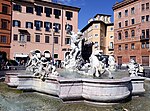Epitaph of Adriaen Vryburch
1620s sculptures1630s sculpturesMarble sculpturesMarble sculptures in ItalySculptures by François Duquesnoy ... and 2 more
Sculptures in ItalySculptures in Rome

Epitaph of Adriaen Vryburch is a sculptural monument by Flemish sculptor François Duquesnoy. The epitaph sits on the pier directly opposite to the Tomb of Ferdinand van den Eynde in the church of Santa Maria dell'Anima in Rome. The epitaph was completed in 1629.
Excerpt from the Wikipedia article Epitaph of Adriaen Vryburch (License: CC BY-SA 3.0, Authors, Images).Epitaph of Adriaen Vryburch
Via di Santa Maria dell'Anima, Rome Municipio Roma I
Geographical coordinates (GPS) Address Nearby Places Show on map
Geographical coordinates (GPS)
| Latitude | Longitude |
|---|---|
| N 41.89975 ° | E 12.472027777778 ° |
Address
Chiesa di Santa Maria dell'Anima
Via di Santa Maria dell'Anima 66
00186 Rome, Municipio Roma I
Lazio, Italy
Open on Google Maps









